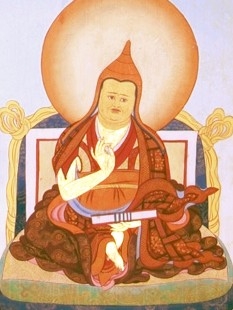Beacon of Certainty

Beacon of Certainty (Tib. Ngeshé Drönmé; Wyl. nges shes sgron me) — a text by Mipham Rinpoche. It was composed by Jamgön Mipham Rinpoche at the age of seven[1]. Definitive knowledge needs to be arrived at in order to attain the fruit of the path. In this text the young Mipham answers seven questions going through the different approaches of the diverse traditions of Tibetan tradition, in order to bring about this definitive knowledge.
While giving insight into the key points of view and meditation on the level of madhyamaka and tantra, the main purpose of this text is to elucidate the teachings of Dzogchen[2], and the introduction to Khenpo Kunpal's commentary reads:
- This Precious Beacon of Certainty is like an eye that brings all the difficult points of sutra and tantra into focus. Externally, it accords with Prasangika; internally, it accords with the Sutra that Gathers all Intentions (Tib. Gongpa Düpé Do ; Wyl. dgongs pa ’dus pa’i mdo) and the Guhyagarbha Tantra; secretly, it accords with the Great Perfection[3].
In his own introduction to the text, Khenpo Jamyang Drubpé Lodrö writes:
- This sacred work, The Precious Beacon of Certainty, sheds its light of definitive understanding on important points from our own and other tenet systems.
- It is a dragon’s roar to wake us from the sleep of foolish meditation,
- And a sword to cut through error and wrong view.
- With crucial points drawn from sutras and tantras of definitive meaning,
- Showing the progressive stages on the Great Vehicle’s general path of sutra and mantra,
- For the Ancient Translation School, the unique tradition of the Lake-born Buddha.
Structure of the Text
The text is structured as answers to the following seven questions:
- According to which of the two negations do you explain the view?
- Do arhats realize both types of selflessness?
- Does meditation involve grasping at an object?
- Should we do analytical meditation or settling meditation?
- Which of the two truths is most important?
- What is the common object of disparate perceptions?
- Does Madhyamaka have a position or not?
Translations
- John W. Pettit, Mipham's Beacon of Certainty: Illuminating the View of Dzogchen, the Great Perfection Studies in Indian and Tibetan Buddhism, Wisdom Publications, 1999
Commentaries
- Khenpo Kunpal, nges shes rin po che'i sgron me'i tshig gi don gsal ba'i 'grel chung blo gros snang ba'i sgo 'byed
- Khenpo Nüden
- Troshul Jamdor, rnam bshad 'od zer dri med
- Khenpo Jamyang Drubpé Lodrö, nges shes rin po che'i sgron me'i rnam par bshad pa nges don sprin dkar glal ba'i sgra dbyangs
It is also said that Pöpa Tulku's Distinguishing Views and Tenets is a 'meaning commentary' on Beacon of Certainty.
Teachings given to the Rigpa Sangha
- Khenpo Pema Sherab, Shedra West, Lerab Ling, 26 May - 6 June, 2010
Notes
- ↑ According to Khenpo Jikmé Phuntsok and Troshul Jamdor.
- ↑ John W. Pettit, Mipham's Beacon of Certainty: Illuminating the View of Dzogchen, the Great Perfection Studies in Indian and Tibetan Buddhism (Boston: Wisdom Publications, 1999), page 5.
- ↑ Ibid. page 128